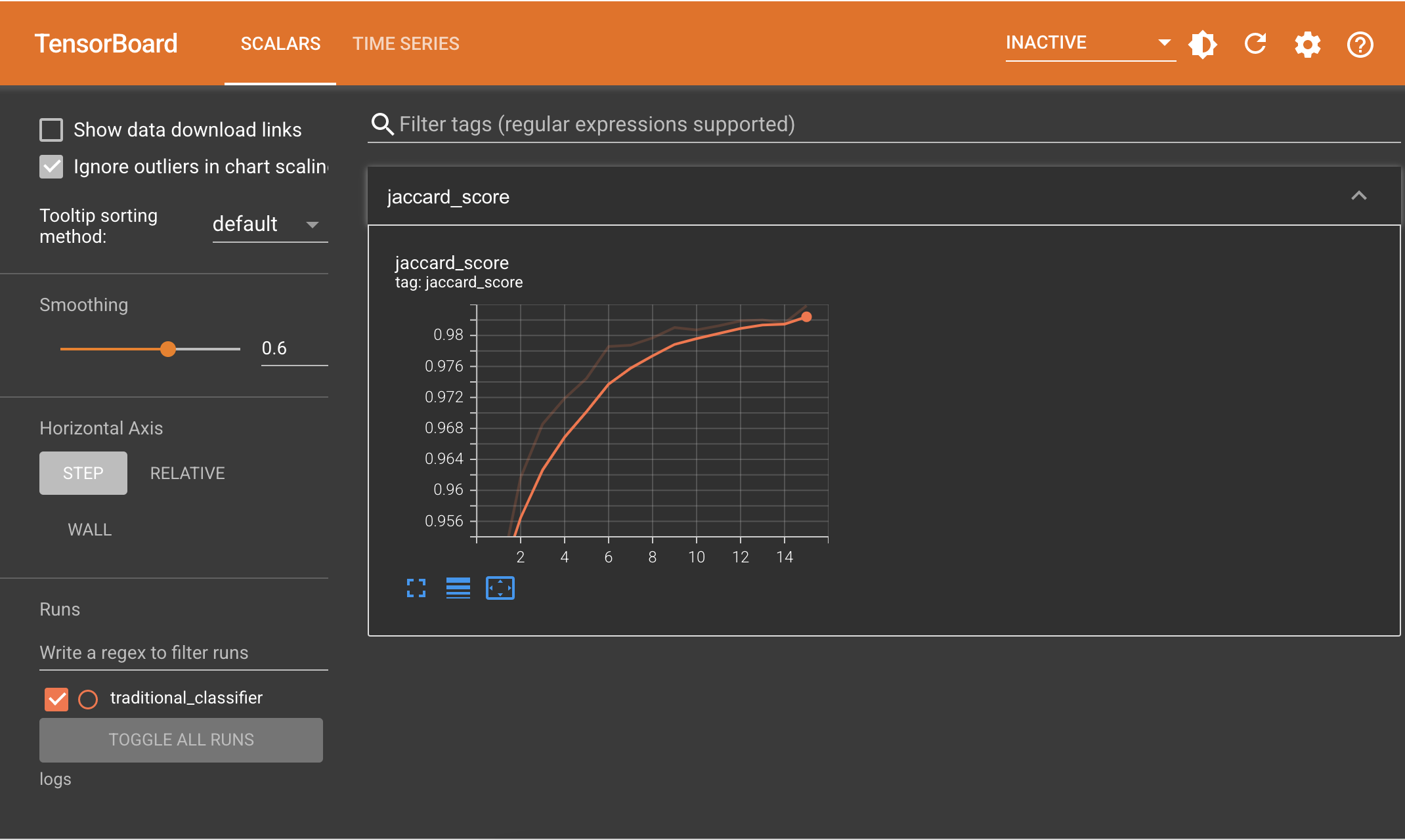Evaluating and exporting scikit-learn metrics in a Keras callback
- Original Link : https://keras.io/examples/keras_recipes/sklearn_metric_callbacks/
- Last Checked at : 2024-11-24
Author: lukewood
Date created: 2021/10/07
Last modified: 2023/11/17
Description: This example shows how to use Keras callbacks to evaluate and export non-TensorFlow based metrics.
Introduction
Keras callbacks allow for the execution of arbitrary code at various stages of the Keras training process. While Keras offers first-class support for metric evaluation, Keras metrics may only rely on TensorFlow code internally.
While there are TensorFlow implementations of many metrics online, some metrics are implemented using NumPy or another Python-based numerical computation library. By performing metric evaluation inside of a Keras callback, we can leverage any existing metric, and ultimately export the result to TensorBoard.
Jaccard score metric
This example makes use of a sklearn metric, sklearn.metrics.jaccard_score(), and writes the result to TensorBoard using the tf.summary API.
This template can be modified slightly to make it work with any existing sklearn metric.
import os
os.environ["KERAS_BACKEND"] = "tensorflow"
import tensorflow as tf
import keras as keras
from keras import layers
from sklearn.metrics import jaccard_score
import numpy as np
import os
class JaccardScoreCallback(keras.callbacks.Callback):
"""Computes the Jaccard score and logs the results to TensorBoard."""
def __init__(self, name, x_test, y_test, log_dir):
self.x_test = x_test
self.y_test = y_test
self.keras_metric = keras.metrics.Mean("jaccard_score")
self.epoch = 0
self.summary_writer = tf.summary.create_file_writer(os.path.join(log_dir, name))
def on_epoch_end(self, batch, logs=None):
self.epoch += 1
self.keras_metric.reset_state()
predictions = self.model.predict(self.x_test)
jaccard_value = jaccard_score(
np.argmax(predictions, axis=-1), self.y_test, average=None
)
self.keras_metric.update_state(jaccard_value)
self._write_metric(
self.keras_metric.name, self.keras_metric.result().numpy().astype(float)
)
def _write_metric(self, name, value):
with self.summary_writer.as_default():
tf.summary.scalar(
name,
value,
step=self.epoch,
)
self.summary_writer.flush()Sample usage
Let’s test our JaccardScoreCallback class with a Keras model.
# Model / data parameters
num_classes = 10
input_shape = (28, 28, 1)
# The data, split between train and test sets
(x_train, y_train), (x_test, y_test) = keras.datasets.mnist.load_data()
# Scale images to the [0, 1] range
x_train = x_train.astype("float32") / 255
x_test = x_test.astype("float32") / 255
# Make sure images have shape (28, 28, 1)
x_train = np.expand_dims(x_train, -1)
x_test = np.expand_dims(x_test, -1)
print("x_train shape:", x_train.shape)
print(x_train.shape[0], "train samples")
print(x_test.shape[0], "test samples")
# Convert class vectors to binary class matrices.
y_train = keras.utils.to_categorical(y_train, num_classes)
y_test = keras.utils.to_categorical(y_test, num_classes)
model = keras.Sequential(
[
keras.Input(shape=input_shape),
layers.Conv2D(32, kernel_size=(3, 3), activation="relu"),
layers.MaxPooling2D(pool_size=(2, 2)),
layers.Conv2D(64, kernel_size=(3, 3), activation="relu"),
layers.MaxPooling2D(pool_size=(2, 2)),
layers.Flatten(),
layers.Dropout(0.5),
layers.Dense(num_classes, activation="softmax"),
]
)
model.summary()
batch_size = 128
epochs = 15
model.compile(loss="categorical_crossentropy", optimizer="adam", metrics=["accuracy"])
callbacks = [
JaccardScoreCallback(model.name, x_test, np.argmax(y_test, axis=-1), "logs")
]
model.fit(
x_train,
y_train,
batch_size=batch_size,
epochs=epochs,
validation_split=0.1,
callbacks=callbacks,
)Result
x_train shape: (60000, 28, 28, 1)
60000 train samples
10000 test samplesModel: "sequential"
┏━━━━━━━━━━━━━━━━━━━━━━━━━━━━━━━━━┳━━━━━━━━━━━━━━━━━━━━━━━━━━━┳━━━━━━━━━━━━┓
┃ Layer (type) ┃ Output Shape ┃ Param # ┃
┡━━━━━━━━━━━━━━━━━━━━━━━━━━━━━━━━━╇━━━━━━━━━━━━━━━━━━━━━━━━━━━╇━━━━━━━━━━━━┩
│ conv2d (Conv2D) │ (None, 26, 26, 32) │ 320 │
├─────────────────────────────────┼───────────────────────────┼────────────┤
│ max_pooling2d (MaxPooling2D) │ (None, 13, 13, 32) │ 0 │
├─────────────────────────────────┼───────────────────────────┼────────────┤
│ conv2d_1 (Conv2D) │ (None, 11, 11, 64) │ 18,496 │
├─────────────────────────────────┼───────────────────────────┼────────────┤
│ max_pooling2d_1 (MaxPooling2D) │ (None, 5, 5, 64) │ 0 │
├─────────────────────────────────┼───────────────────────────┼────────────┤
│ flatten (Flatten) │ (None, 1600) │ 0 │
├─────────────────────────────────┼───────────────────────────┼────────────┤
│ dropout (Dropout) │ (None, 1600) │ 0 │
├─────────────────────────────────┼───────────────────────────┼────────────┤
│ dense (Dense) │ (None, 10) │ 16,010 │
└─────────────────────────────────┴───────────────────────────┴────────────┘
Total params: 34,826 (136.04 KB)
Trainable params: 34,826 (136.04 KB)
Non-trainable params: 0 (0.00 B)Epoch 1/15
313/313 ━━━━━━━━━━━━━━━━━━━━ 1s 2ms/step
422/422 ━━━━━━━━━━━━━━━━━━━━ 7s 16ms/step - accuracy: 0.7706 - loss: 0.7534 - val_accuracy: 0.9768 - val_loss: 0.0842
Epoch 2/15
313/313 ━━━━━━━━━━━━━━━━━━━━ 1s 2ms/step
422/422 ━━━━━━━━━━━━━━━━━━━━ 7s 16ms/step - accuracy: 0.9627 - loss: 0.1228 - val_accuracy: 0.9862 - val_loss: 0.0533
Epoch 3/15
313/313 ━━━━━━━━━━━━━━━━━━━━ 1s 2ms/step
422/422 ━━━━━━━━━━━━━━━━━━━━ 7s 16ms/step - accuracy: 0.9739 - loss: 0.0854 - val_accuracy: 0.9870 - val_loss: 0.0466
Epoch 4/15
313/313 ━━━━━━━━━━━━━━━━━━━━ 1s 2ms/step
422/422 ━━━━━━━━━━━━━━━━━━━━ 7s 17ms/step - accuracy: 0.9787 - loss: 0.0676 - val_accuracy: 0.9892 - val_loss: 0.0416
Epoch 5/15
313/313 ━━━━━━━━━━━━━━━━━━━━ 1s 2ms/step
422/422 ━━━━━━━━━━━━━━━━━━━━ 7s 17ms/step - accuracy: 0.9818 - loss: 0.0590 - val_accuracy: 0.9892 - val_loss: 0.0396
Epoch 6/15
313/313 ━━━━━━━━━━━━━━━━━━━━ 1s 2ms/step
422/422 ━━━━━━━━━━━━━━━━━━━━ 7s 17ms/step - accuracy: 0.9834 - loss: 0.0534 - val_accuracy: 0.9920 - val_loss: 0.0341
Epoch 7/15
313/313 ━━━━━━━━━━━━━━━━━━━━ 1s 2ms/step
422/422 ━━━━━━━━━━━━━━━━━━━━ 7s 17ms/step - accuracy: 0.9837 - loss: 0.0528 - val_accuracy: 0.9907 - val_loss: 0.0358
Epoch 8/15
313/313 ━━━━━━━━━━━━━━━━━━━━ 1s 2ms/step
422/422 ━━━━━━━━━━━━━━━━━━━━ 8s 18ms/step - accuracy: 0.9847 - loss: 0.0466 - val_accuracy: 0.9908 - val_loss: 0.0327
Epoch 9/15
313/313 ━━━━━━━━━━━━━━━━━━━━ 1s 2ms/step
422/422 ━━━━━━━━━━━━━━━━━━━━ 7s 18ms/step - accuracy: 0.9873 - loss: 0.0397 - val_accuracy: 0.9912 - val_loss: 0.0346
Epoch 10/15
313/313 ━━━━━━━━━━━━━━━━━━━━ 1s 2ms/step
422/422 ━━━━━━━━━━━━━━━━━━━━ 8s 18ms/step - accuracy: 0.9862 - loss: 0.0419 - val_accuracy: 0.9913 - val_loss: 0.0315
Epoch 11/15
313/313 ━━━━━━━━━━━━━━━━━━━━ 1s 2ms/step
422/422 ━━━━━━━━━━━━━━━━━━━━ 7s 17ms/step - accuracy: 0.9880 - loss: 0.0370 - val_accuracy: 0.9915 - val_loss: 0.0309
Epoch 12/15
313/313 ━━━━━━━━━━━━━━━━━━━━ 1s 2ms/step
422/422 ━━━━━━━━━━━━━━━━━━━━ 7s 17ms/step - accuracy: 0.9880 - loss: 0.0377 - val_accuracy: 0.9912 - val_loss: 0.0318
Epoch 13/15
313/313 ━━━━━━━━━━━━━━━━━━━━ 1s 2ms/step
422/422 ━━━━━━━━━━━━━━━━━━━━ 7s 17ms/step - accuracy: 0.9889 - loss: 0.0347 - val_accuracy: 0.9930 - val_loss: 0.0293
Epoch 14/15
313/313 ━━━━━━━━━━━━━━━━━━━━ 1s 2ms/step
422/422 ━━━━━━━━━━━━━━━━━━━━ 7s 16ms/step - accuracy: 0.9896 - loss: 0.0333 - val_accuracy: 0.9913 - val_loss: 0.0326
Epoch 15/15
313/313 ━━━━━━━━━━━━━━━━━━━━ 1s 2ms/step
422/422 ━━━━━━━━━━━━━━━━━━━━ 8s 18ms/step - accuracy: 0.9908 - loss: 0.0282 - val_accuracy: 0.9925 - val_loss: 0.0303
<keras.src.callbacks.history.History at 0x17f0655a0>If you now launch a TensorBoard instance using tensorboard --logdir=logs, you will see the jaccard_score metric alongside any other exported metrics!

Conclusion
Many ML practitioners and researchers rely on metrics that may not yet have a TensorFlow implementation. Keras users can still leverage the wide variety of existing metric implementations in other frameworks by using a Keras callback. These metrics can be exported, viewed and analyzed in the TensorBoard like any other metric.